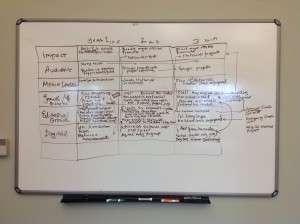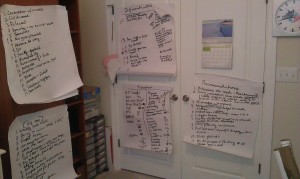What is the Jim Russell “Intensive?”
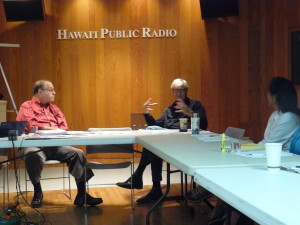 Making a new program or “fixing” an old one — is hard work. In fact, the “Intensive” I have created … sounds like outpatient surgery! Actually, it is a lot more fun, stimulating and usually more productive. It is my approach to new program development (or analyzing and fixing an existing show.)
Making a new program or “fixing” an old one — is hard work. In fact, the “Intensive” I have created … sounds like outpatient surgery! Actually, it is a lot more fun, stimulating and usually more productive. It is my approach to new program development (or analyzing and fixing an existing show.)
The process was created when I was Senior Vice President of New Program Development at American Public Media and Minnesota Public Radio. The first time we did it, it took 3+ months! But, nobody can afford that kind of time, so when I became a consultant, I tightened it up considerably and found that a thinned-down version could be done in 5 days of hard work by a staff. Then, just to drive myself crazy, I halved the time … to 2 1/2 days! I’ve done it repeatedly since then, for a variety of stations and producers, so I know …It works!
What is Jim Russell’s Intensive?
It is a systematic, rigorous creation and construction of a program — one that forces us to address all of the creative and the strategic questions, such as
- Why are we doing this?
- What are we doing
- How will it be unique?
- What “Signature Segments” will make it so?
- What is our “Bible” of best practices, our roadmap that guarantees we consistently produce the program we want to produce?
- How will we budget it, create it, over what timetable, promote it, and measure it to know if we’re successful?
Day 1 – Arrival:
I normally arrive on a Sunday afternoon, and the process begins that evening with the last leisurely thing that will happen in the next several days: a dinner with the senior team, including the General Manager and Program Director as well as the senior producers involved in the project. While the purpose is to get acquainted, it is also to discuss what the Station (or other producing entity) wants, what its motivation is for producing a program, and what its expectations are. And, I will sketch what is going to happen in the next day and a half.
Day 2: “The Intensive”
Bright and early the next day, usually at 8:00 am, the meeting begins. In attendance is the project’s entire production staff, as well as station senior management, and the heads of marketing, underwriting, publicity/promotion and any other appropriate support divisions. (Station management and other support people can leave as they need to after this first session.) It is critical that the heads of support services participate so that a genuine team is assembled – a team with a common vision and with shared goals.
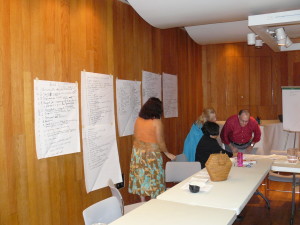 What is right or wrong with the present information/talk programming? What are the strengths and weaknesses of current information/talk programming?
What is right or wrong with the present information/talk programming? What are the strengths and weaknesses of current information/talk programming?
- What are some examples of successful news and public affairs programs that you admire? Why do you admire them?
- Are there historical, cultural or institutional restraints that might impact the success of programs?
My role is to lead the staff through a very fast-moving, energizing process of discovery and creating a plan. By the end of the meeting (on Day 2), we intend to have answered a lot of questions and nailed down a great many areas of the new program.
What is the Rationale and the Charge:
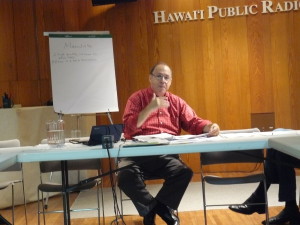 The meeting begins with the head honcho (the GM or the PD) telling the entire group why the Station is embarking on this effort, why it makes sense and connects with the Station’s overall strategic plans. Management will articulate what it is expecting and how it will measure the project’s success.
The meeting begins with the head honcho (the GM or the PD) telling the entire group why the Station is embarking on this effort, why it makes sense and connects with the Station’s overall strategic plans. Management will articulate what it is expecting and how it will measure the project’s success.
The Mission:
What is the program’s vision and mission? The staff writes (or revisits), discusses and perfects the Mission Statement. The group effort at writing the statement – written on a big board — is full of suggestions, changes, refinements and joint authorship.
Reality Test: Evaluation of The Idea and Station’s Capacity:
- Can our Station do this? What are the strengths and weaknesses we bring to thetable, what are the threats and opportunities? Who is the competition?
- Who is the audience? Can we demonstrate that there is demand and opportunity for such a program?
- Funding: In round numbers, what does this cost and how is it being paid for?
- Key Talent: Who are the key talent and do we have a “lock” on them?
The Differentiators:
The real test of what a program will work and hold its own in the market is its uniqueness, its ability to hold its own space in the market. We need to ask and answer:
What are the key characteristics and qualities of the program that differentiate it from others?
What assets and resources do we have that nobody else does? Design the Show:
- THE BIBLE: What are the 10 Commandments of this program – the things that every program must include, the qualities that every show and most segments must display.
- THE CLOCK: What does the program’s format look like? The pieces of the programs are the “rooms.”
- THE FURNITURE: What are the regular segments that always appear in the rooms, the segments that are the show’s signature elements?
What does it “sound” like? We put together the pieces and describe the program we’ve invented.
- Discuss the next steps, including timetable, budget, staffing, legals, piloting, marketing and publicity, measurement of success.
- Staff Briefs “the Suits”: We bring the management back in and tell them what we have accomplished, and describe out program to them: its Mission, Audience, Differentiators, Preliminary Budget Estimate, Bible, Clock and Signature Segments.
Day 3: (Half Day)
The morning is spent outlining and prioritizing the group’s conclusions, and ends with a briefing of senior management about the recommended next steps and budget, staffing and other resource issues. I usually depart around lunchtime, and return home with reams of paper collected in the Intensive.
Within a few weeks of the session, I send a formal written report to the Station’s senior management.
The cost for the Intensive is $7,500 – $10,000. Please contact Jim if you are interested in scheduling an Intensive for your station.


